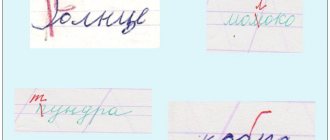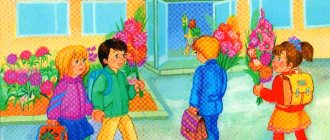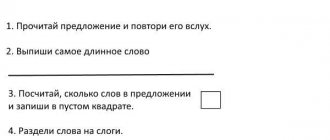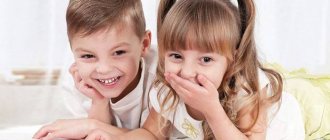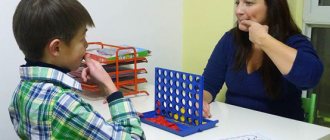If a child writes poorly - rearranges or skips letters, makes “stupid” mistakes in well-known words - primary school teachers usually advise “study more”, they say, over time quantity will turn into quality. But neuropsychologists believe that simple rewriting does little to develop the frontal lobes of the brain - this is precisely why writing suffers. And they offer their own tasks that will help you write correctly and accurately.
Neuropsychological correction - what is it?
Neuropsychology is a science that studies mental processes in the brain: perception, attention, spatial orientation, speech, memory, emotional response, motor skills, etc.
Physical development of the baby
These processes are the main ones that determine the success of a child’s development and learning ability. If they are not formed, then learning is difficult, a dislike for learning appears, and psychosomatic diseases may develop.
Note! The technique is used to correct disorders in the mental functions of children from 3 to 12 years old. It is believed that they all have a common root: a deficiency of adaptive or the presence of maladaptive neural connections in the brain.
Often parents realize that something is wrong, but do not take any action, which leads to problems in the future. To avoid this, you should visit a neuropsychologist for a consultation if your baby has:
- there are problems with memory, communication, performance;
- speech therapy disorders, speech delay;
- disturbances of psychomotor development, sleep, appetite;
- communication problems;
- lethargy or hyperactivity;
- low level of self-control, impulsiveness;
- problems with mastering writing, reading, and counting.
For your information! The process of brain formation lasts throughout human life. It has a strict order and goes through certain stages. For one reason or another, they may be disrupted, which leads to general developmental problems.
In addition, some mental functions may not be fully formed or in a distorted form. In this case, behavior correction is indicated. The following signs indicate that the child should be sent for diagnostics:
- writes mirror;
- skips letters;
- rearranges parts of words when writing;
- has problems with switching;
- has trouble concentrating;
- doesn't like to draw;
- stammers, gets tired quickly;
- there are tics or obsessive movements;
- absent-minded;
- had a history of concussion, general anesthesia, and serious illness;
- crawled a little.
Correction helps improve the situation in the presence of such developmental problems:
- speech development delays, speech underdevelopment;
- delays in mental and psycho-speech development (DSD);
- hyperactivity and attention deficit;
- autism;
- minimal brain function;
- underdevelopment of the brain body;
- emotional and mental disorders.
Specialist's work
Important! Thanks to a special set of exercises, a specialist can consistently activate each area of the brain.
The program is developed individually based on tactile-kinesthetic correlation methods and the most effective approaches from related disciplines.
Exercises to develop the frontal lobes of the cerebral cortex
- Please. We show various gestures, and the child must repeat them when he hears the magic word “please.” Gradually increase the pace of your gestures.
- It's the other way around. Let's clap our hands. When you clap 1 time, the child should clap 2 times. And vice versa: when you clap 2 times, he claps 1 time. Options: tapping your hand on the table or wooden spoons, stomping your foot, etc. Exercise improves the dynamics of mental processes, teaches you to quickly switch from one task to another.
- Arms, legs, head. We name the parts of the body, and the child must show them. But you need to be very careful, since you should show the part of the body that was named earlier. For example, you say “hands”, the child does not show anything. Then you say “head”, he shows his hands. You call “legs”, he touches the head.
- Rings. We connect the thumb of the left hand with the other fingers into rings one by one, starting with the index finger. We connect the thumb of the right hand with other fingers, starting with the little finger. Do it with both hands at the same time. We train concentration and switching of attention, as well as control and order of performing a series of movements.
- Games of our childhood. Games familiar to everyone from childhood will also help: “Edible - inedible”, “Sparrows - crows”, “Don’t say yes and no, don’t take black and white.”
- Gulliver and the Lilliputians. We invite the child to rewrite the words, starting with the largest or smallest letter, and then in descending or ascending order.
From the smallest letter to the largest.
From the largest letter to the smallest.
Components of neurocorrection in childhood
In childhood, two correction methods are used:
- motor;
- cognitive.
The first method promotes stimulation of individual zones of the cerebral cortex, which are responsible for the regulation of movements, improvement of interhemispheric interaction, and development of associative connections. Cognitive correction is aimed at developing cognitive skills and overcoming learning difficulties.
Lesson on fine arts on the topic “Mimosa” in the 1st and 2nd junior groups of a preschool educational institution
Note! To motivate the child, all neuropsychological classes with children are carried out only in a playful way. A course of neuropsychological gymnastics should consist of at least 20 sessions, and the duration of one of them is 40-80 minutes. depending on age.
Exercises to develop interhemispheric interaction
- We write our name with one hand, and the word “well done” with the other.
- We draw a man with one hand - from circles, with the other - from rectangles.
- We color the picture with both hands. Moreover, we color the right part of the picture with the left hand, and the left part of the picture with the right.
- We trace the outline of the picture with both hands at once.
Classes with a neuropsychologist for preschool children
Neuropsychological correction in childhood, exercises that include eye movements, crawling, squeezing arms and legs, helps to start the brain working in the right direction. Oculomotor exercises are considered one of the most effective; neuropsychology uses them for many ages, including preschoolers.
All neuropsychological exercises for children are carried out in strict sequence and under the supervision of an adult. Then they contribute to the activation of higher psychological functions: emotions, perception, attention, memory, thinking. In this way, the baby learns to overcome the maladaptive features of his development, his childhood behavioral problems and difficulties in school learning and self-regulation disappear.
Board games
There are many good board games that can be used to develop a child with ADHD. A prerequisite for selecting board games for such a child is the absence of monotony. Finding board games that might interest a hyperactive child is not such an easy task. However, it is highly advisable for parents to make efforts in this direction.
First of all, the rules and conditions of board games are completely clear, not vague or controversial. As a result, this is a very good opportunity for a child to train attention. Since the moves in such a game are made in turns, the hyperactive child learns to wait and control his impulses
Board games are beneficial for a hyperactive child in many ways. For example, they teach such a child to follow certain rules and develop the ability for productive, goal-oriented activity.
Neurocorrection for children: exercises at home for beginners depending on age
Each exercise is designed for a specific age. Until 5-6 years old, it is important to praise a child, even if he doesn’t succeed. Constant reminders of your shortcomings can discourage you from working out. Children may later recognize false praise and should be encouraged to succeed.
Note! Many interesting books have been written on this topic. One of the highest quality is a practical manual by V. S. Kolganov and E. V. Pivovarov.
Useful Guides for Beginners
Using the following examples, it is easy to understand what neuropsychological correction is; its exercises are presented below.
Note! The number of tasks that can be used is quite large.
"River-bank"
This game is usually used at holidays, but in neuropsychology it is modified in such a way that it can be played with one participant.
- You will need a rope, it needs to be placed on the floor so that it marks the coastline.
- The participant stands on one side of the rope, on the other the river flows. The psychologist invites the child to follow his commands “river”, “bank”. The child must jump accordingly.
- In the first part of the game, the psychologist randomly gives commands and sees if the child can carry them out correctly. Then he begins to give them in the correct order until the baby gets used to it.
- Suddenly the order changes, the child’s task is to switch. If he regularly makes mistakes, he should be asked to take his time. This is good for dealing with impulsiveness.
Important! This exercise is well suited for children aged 5 years and older to develop reaction and attention skills.
"Robot Mom"
This exercise is aimed at getting the child to tell the other person what to do. Moreover, he should mainly speak, and not show.
- You should imagine that mom has forgotten how to do the most ordinary things and she needs a guide to help with this.
- You should do what the child says literally, without adding anything of your own. If you don’t need to cut the bread to create a sandwich, then this is exactly what you should repeat. It is important that the child sees that the result of his planning is not exactly what it should be, and that he adjusts his actions.
Drawing classes for children 2-3 years old - teaching the baby
Another option is to blindfold the mother and let the child explain how to get to a certain place or object. This must be done by indicating the number of steps.
Daughter tells mom how to bake a pie
For older children, you can use a version of the exercise with graphic dictation. The child draws an object on a piece of paper in a box, repeating only the lines already drawn, and then explains to his mother how to draw the same thing in the boxes.
Note! The exercises are suitable for children over 5 years old. Performed individually and in pairs. Helps develop planning skills.
"Fly"
You need to take a piece of paper and draw it into 16 cells (4 by 4). Separately, draw a fly and cut it out (you can use an object that will symbolize it, for example, a button). Place the fly on an arbitrary cell and order it to move in a certain direction.
After several such orders (a cell up, two cells down, etc.), ask the child where the fly is now. If the correct answer is given, move it to the appropriate square; if not, repeat and demonstrate its movement.
Game for developing attention “Corrector”
First of all, you should explain to your child what exactly a proofreader does. Next, take a large magazine or book and select the “wrong” letters in it, for example, Ж, И, Б. Moreover, this must be done within a certain time.
Note! If the child completed the exercise correctly, praise him.
If mistakes were made, recalculate them and track daily dynamics. A situation when there are fewer errors will be considered a success. The game is very useful for inattentive children.
Timed search for letters
“I’m silent - I whisper - I scream”
You should come up with signs that indicate what exactly needs to be done: be silent, whisper or shout and show them to the child. He must react accordingly.
Such neuropsychological games and exercises develop control skills in hyperactive children. They help them regulate the volume of their statements and remain silent when necessary.
"Touch"
To play, you will need objects made from various materials: glass, wood, fur, etc. They should be placed on the table near the child, and he should be blindfolded. Offer to determine what exactly the object is in his hands.
For your information! The game helps relieve muscle and emotional tension in hyperactive children. It is also suitable for younger children.
There will certainly be an effect from the exercises if you do everything regularly and correctly. You just need to be patient and, no matter what the child does, react calmly.
Noisy games
Often a hyperactive child chooses noisy games. This is natural, because it is difficult for him to restrain himself and it is difficult for him to stay in one place. Therefore, it is quite logical to select outdoor games for him. Outdoor games according to the rules not only develop certain qualities, they also teach a hyperactive child to discipline, to subordinate his activities to a specific goal. Games with very clear rules help develop attention.
In outdoor games, a child with ADHD also develops emotionally. He learns to control his behavior, learns to endure and wait, to put off what he wants for later. All these qualities will later be useful to him in communicating with peers and adults.
Outdoor games also develop a child's thinking. After all, he must always keep several components of the situation in his head and operate with them mentally. The child also learns to notice details. If he doesn't take something into account or forgets, he may lose.
Outdoor games develop a child physically, train his dexterity, flexibility, and teach him to avoid traumatic situations. Finally, if a child begins to be able to play with other children, this increases his self-esteem and authority in the eyes of other children.
Computer games
Syndromic approach
Syndromic work is that the child is given a voluntary activity that is interesting from the point of view of a psychologist/teacher. This activity, of course, is selected taking into account the preferences of the individual child.
As a result of this activity, post-voluntary attention arises. Post-voluntary attention is when a person first makes an effort, and then he becomes interested and he already maintains a level of active attention without tension
Computer games
It is on voluntary attention that hyperactive children’s passion for computer games is formed. Despite all the complaints from various experts about sitting at a computer, computer games have many positive aspects.
The limited computer display space allows you to organize the attention of a hyperactive child. A hyperactive child may become tired faster than anyone else, but not distracted. Computer games and exercises are quite exciting activities, which correspond very well to the emotional characteristics of a hyperactive child. in case of failure, the child can repeat the entire game or stage of the game, and comparing his results with previous ones, make sure that now he is doing better. a computer is very visual and intuitive, which allows a hyperactive child to better assimilate any material. If you limit the time a child spends at a computer, then you can use computer resources to develop his deficit functions
If you limit the time a child spends at the computer, then you can use computer resources to develop his deficit functions.
Principles
This young science has its fundamental principles:
- Social conditioning: the formation of psychological processes is possible only in society.
- Material determinism: the basis of the psyche is the work of the nervous system.
- Systematic structure: mental processes have their own strict hierarchy and system, as well as the higher nervous system with its variety of levels.
- Dynamics in development - all functions are in constant motion and change.
- Syndromic: pathological mental processes are based on certain syndromes, which include both anatomical and functional manifestations.
Just like any other medical science, neuropsychology is based on the principles of ethics and deontology, which acquire special significance in relation to higher nervous activity.
The characterization of human psychology as a product of the nervous system and social influence has led to the formation of religious and moral conflicts, so it is important to observe these principles very carefully. Any neuropsychological study must take into account the factor of public opposition in this regard
Any neuropsychological study must take into account the factor of public opposition in this regard.
Training two functions at once
Having worked on the development of one function and received positive results, you can move on to training two functions at once
For example, attention and impulse control or attention and motor control can be trained through play.
When a hyperactive child has experience participating in group games to develop two functions at once, you can gradually begin to engage with him in more complex play forms that involve the development of all functions at once in the same game.
“Listen to the clapping” (Chistyakova M.I., 1990)
Goal: training attention and control of motor activity.
Everyone walks in a circle or moves around the room in a free direction. When the leader claps his hands once, the children should stop and take the “stork” pose (stand on one leg, arms to the sides) or some other pose. If the leader claps twice, the players should take the “frog” pose (sit down, heels together, toes and knees to the sides, hands between the feet on the floor). After three claps, the players resume walking.
“Shouters, whisperers, silencers” (Shevtsova I.V.)
Goal: development of observation, ability to act according to the rule, control of motor activity.
You need to make 3 silhouettes of a palm from multi-colored cardboard: red, yellow, blue. These are signals. When an adult raises a red palm - a “chant” - you can run, scream, make a lot of noise; yellow palm - “whisper” - you can move quietly and whisper, when the signal “silent” - blue palm - children should freeze in place or lie down on the floor and not move. The game should end with silence.
“Giant slalom” Development of attention and control of motor activity.
Two parallel slalom “courses” are made from chairs, which competing teams must overcome, moving backwards at both ends. The one who, while maneuvering between the chairs, touches one of them, returns to the start for a second attempt. The first team to complete the course without errors wins.
"Ball in a Circle"
Standing in a circle, participants throw 1, 2, 3 or more balls to each other, signaling their intentions without using words. The one whose thrown ball was not caught is eliminated.
"Bench"
Control of impulses and motor activity.
Anyone who is eliminated from any game must sit in a chair until it ends. If he gets up from his chair or spins around, the entire team will be penalized or forfeited.
"Climbers"
Concentration, control of impulsive movements
Participants must walk along a free wall, leaning against it over and over again with at least three limbs. Anyone who tears off or moves two limbs at the same time is considered “lost” and returns to the start. The first team to reach the opposite corner wins.
“Edible - inedible”, “Don’t wear black and white”, don’t say “yes” and “no” and similar games that require self-control to avoid impulsive reactions.
